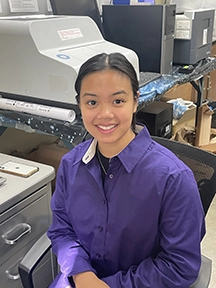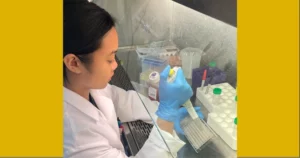Amy Reyes got a late start on her research, but she’s learned it’s never too late to make a difference.
Reyes is a senior on the pre-optometry track at UWM, set to graduate with a major in biology and a minor in chemistry this spring. She’s also an undergraduate researcher working with the Simmaron Research Institute, a nonprofit organization that collaborates with the Milwaukee Institute for Drug Discovery at UWM.
Under the guidance of her mentor, Dr. Avik Roy, Reyes is testing new drugs to treat a particularly aggressive form of breast cancer in hopes of finding the correct dosage to deliver to patients. The medicine is still in early testing phases, but someday, Reyes hopes that her research will improve the lives of cancer patients around the world.
A late start
Most UWM undergraduate researchers begin working with mentors in their sophomore or junior years, but undergraduate research wasn’t even on Reyes’ radar until this past summer. She followed in her brother’s footsteps and attended a summer research camp at the Milwaukee School of Engineering. The 10-week program paired Reyes with a mentor and allowed her to run her own experiments.
“Truthfully, I was thrown into the deep end with research. I had to do a lot of it on my own and learn as I went,” she said, “but because of that, I think I gained a lot of experience in that 10 weeks.”
She worked on creating components for a plant-based sunscreen by researching plants that had UV-absorbing properties and then extracting those compounds from the plant. It will be a long time before a commercial product might be available, “But maybe someday!” Reyes hopes.

When the MSOE summer program ended and her senior year at UWM began, Reyes found she hadn’t shaken the research bug. So, she reached out to Dr. Alexander Arnold, a UWM professor of chemistry and biochemistry and the director of Milwaukee’s Institute for Drug Discovery. He paired Reyes with Dr. Roy.
“I’ve had a lot of one-on-one experience with my mentor. Because of that, I’ve learned so much,” Reyes said. “He’s been teaching me a lot of new techniques, teaching me a lot of biostatistics. This is very new to me, but it’s been a really great experience so far.”
A personal connection
The Simmaron Research Institute is pursuing several lines of inquiry, including research into long COVID and chronic fatigue syndrome, but Reyes is specifically working with Roy on the development of therapies to treat triple-negative breast cancer.
Triple-negative breast cancer is a particularly aggressive form of cancer that accounts for 10-15% of all breast cancers, according to the American Cancer Society. The cancer cells lack estrogen and progesterone receptors, and make little to no HER2, a type of protein. Triple-negative breast cancer tends to be more common in patients who are younger than 40, who are Black, or who have the BRCA 1 gene.
Working with MIDD, Dr. Roy created a novel drug called SIMMPYRA, which is now patent-pending.
“These SIMMPYRAs are STAT3 inhibitors. STAT proteins are a family of proteins that are known to regulate gene expression. Previous research shows that STAT3 is highly active in several different forms of human cancer,” Reyes explained. “Basically, SIMMPYRAs arrest cell proliferation, and cell proliferation can cause cancers. We’ve been trying to find the optimal concentration of this drug that will work on triple-negative breast cancer.
“Treatments that currently exist use drugs that are at a very high concentration, so they have a lot more side effects,” she added. “What’s great about the drugs that we’re using is that we are able to see the same results, but at very low concentrations.”
She’s zeroing in on the correct dosage by performing cytotoxicity assays. In essence, Reyes takes some triple-negative breast cancer cells and then treats them with different concentrations of the drug. Then, she examines the cells under a microscope to see which cells were apoptotic, meaning that they burst and died, and which cells remained healthy.
“I did the painstaking job of counting (the cells) individually to see how many died,” Reyes said with a rueful smile.
The research is important because SIMMPYRA, if it proves to successfully treat triple-negative breast cancer, may someday be used to help patients without having them suffer many of the major side effects of current chemotherapies, like hair loss, fatigue, and nausea. But Reyes has a personal stake in her work: Her mother is a breast cancer survivor.
“She still talks to me about some of the trauma from getting diagnosed,” Reyes confessed. “She doesn’t know much about the research field, but she’s super proud of me and she keeps telling me how lucky I am.”
Reyes’ mother is planning to attend UWM’s Undergraduate Research Symposium this spring to see her daughter present her work. Reyes plans to graduate in May and then take a gap year before attending optometry school. She’s not sure if she’ll continue performing research, but Reyes is glad that she took the chance to get involved. And someday, breast cancer patients may benefit from that chance she took.
By Sarah Vickery, College of Letters & Science
